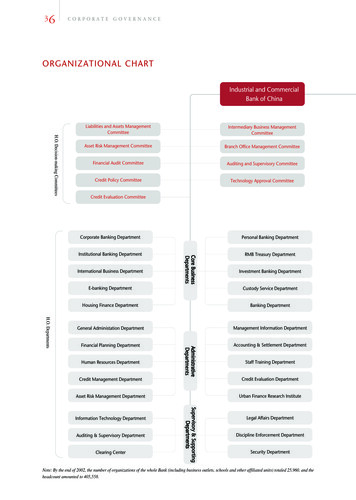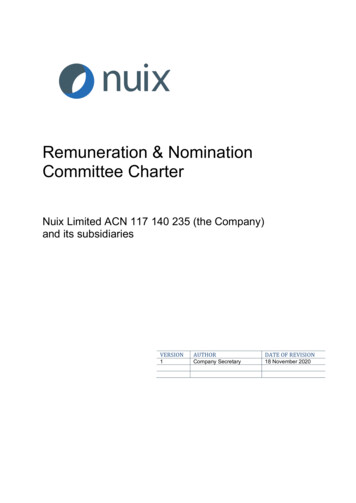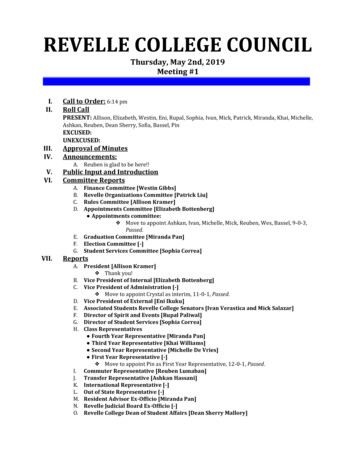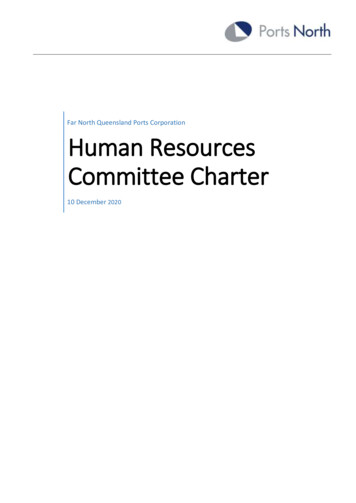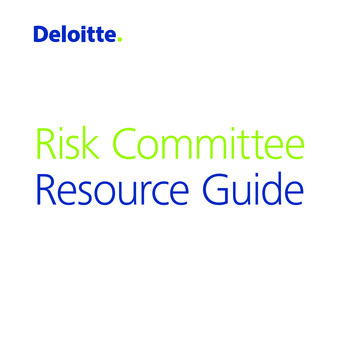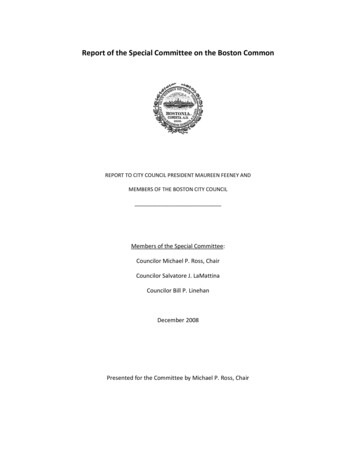
Transcription
Report of the Special Committee on the Boston CommonREPORT TO CITY COUNCIL PRESIDENT MAUREEN FEENEY ANDMEMBERS OF THE BOSTON CITY COUNCILMembers of the Special Committee:Councilor Michael P. Ross, ChairCouncilor Salvatore J. LaMattinaCouncilor Bill P. LinehanDecember 2008Presented for the Committee by Michael P. Ross, Chair
CONTENTSEXECUTIVE SUMMARY . 1Physical Appearance of the Boston Common. 1Developing Positive Activity. 1New York City . 2Recommendations . 2ABOUT THE SPECIAL COMMITTEE On THE BOSTON COMMON . 3PHYSICAL APPEARANCE OF THE BOSTON COMMON . 4PUBLIC SAFETY . 5PARK RANGERS . 6HOMELESSNESS . 7NEW YORK CITY . 8Madison Square Park . 8Bryant Park. 9Central Park/Boathouse. 10FUNDING . 11RECOMMENDATIONS OF THE SPECIAL COMMITTEE ON THE BOSTON COMMON . 12Physical Appearance . 12Developing Positive Activity. 16The Restaurant. 18Funding . 19CONCLUSIONS. 22ACKNOWLEDGEMENTS. 22
REPORT OF THE SPECIAL COMMITTEE ON THE BOSTON COMMONEXECUTIVE SUMMARYThe Boston Common wasestablished in 1634 and isAmerica’s first and oldestpublic park. With 48 acres ofland, there is a need forongoing attention and care,which has at times beeninsufficient.The Common is an important part of the history andtradition of the City of Boston. It houses Boston’sVisitors Center and is the start of the Freedom Trail,thus is memorable for many visitors. It is the frontyard for our state government buildings, a blockfrom the business district, and alongside residentialneighborhoods. The Common is of strategicimportance, encompassing two MBTA stations withaccompanying plazas, and an underground garage.The issues raised in this report recognize the criticalrole the Common plays in our city. This committee islooking for ways to make the Boston Common aneven more central part of our city, maximizing its useby residents and visitors alike, creating a strongervisual icon within the downtown.The report of the Special Committee on the BostonCommon examines data for the conditions of theCommon, and investigates potential options for thepark’s future. Boston’s Department of Parks andRecreation oversees the Boston Common, mostrecently under difficult financial circumstances.There is much to be done, however, and the City ofBoston must improve the maintenance of this worldclass park, even under these tough economic times.This Committee has sought to learn from theexperiences and best practices of other cities facingsimilar problems. We make recommendations basedin part on our research and observation of severalNew York City parks.Physical Appearance of the Boston CommonA walk through of the Common reveals the wear andtear on its turf, statues, and aesthetic features.Difficult budget decisions have forced reductions inthe levels of maintenance and it shows. To make theCommon a destination for those who live and worknearby and those who visit the city, this committeeis seeking to answer the question of how to makethe Common a more welcoming park that is vibrant,clean and safe.Developing Positive ActivityCrime on the CommonFrom 2006 to the summer of 2007 we witnessed adifficult period for the issue of safety on theCommon. In 2007, the Boston Police Departmentbegan to enforce the overnight curfew in an effort tostem the small crime wave in the area. Crimestatistics show some recent successes in crimereduction in the Common through the use of SafeStreet Teams. This heavier presence may only be atemporary fix and may merely be displacing crime toFigure 1. Cracked Sidewalk and cigarette buttsby Park Street StationReport of the Special Committee on the Boston CommonBoston City Council, December 20081
other parts of the neighborhood. We cannot expectstrained police resources to be the only deterrent tocrime. This report makes recommendations toincrease positive activity on the Common, creating abetter and safer environment.Homelessness on the CommonHomelessness is a chronic problem in major U.S.cities. In Boston, our mission is to end homelessness.The Emergency Shelter Commission (ESC) estimatesthat as many as 100 homeless people utilize theCommon as a living space during the summermonths. “Neighborhood team” street outreachprograms are needed during the day, and the ESCengages area ministries in a longer-term strategy tofind housing for the homeless and do the workneeded to allow them to stay in those homes. Anumber of service agencies worked with the ESC tofind housing for 40 percent of those found homelessin the park in 2007 and continues that work today.We recognize the important work of the HousingFirst program. Providing shelter for the homelessshould remain the first priority. We also need toensure that day-to-day social services and outreachcontinues, and that there remain resources availablefor the homeless.New York CityOur committee had an opportunity to visit New YorkCity this past June. Our fact-finding mission wasdesigned to see what was being done at three parksin Manhattan, in order to find ideas that could bebrought to bear on the Common. In New York, wesaw some interesting models. There are great ideasthat have been generated for urban green space inNew York City and great opportunities for our city.The Common and the Department of Parks andRecreation can learn from New York City’s bestpractices.RecommendationsOur recommendations are a foundation for arenewed strategic plan for the Boston Common.They are merely the beginning of the conversation –the jumping-off point for more extensive, moredetailed planning for the Common, as we look torevise the Master Management Plan.Three main issues drive this discussion.1. Maintenance and improvements of the physicalstructures of the park. We need to improve parkinfrastructure, gaining a better understanding ofwhat structures are used by visitors andresidents. There are places where aestheticimprovements can be made and places wheresignificant changes are recommended.2. Encourage more positive activity on theCommon. Bringing positive activity for morehours of the day and more months of the yearimproves public safety on and public commitment to the Common. By finding new ways toexpand hours of use, giving people a largercommitment to the Common, and finding newways of bringing people to the Common, we canattract people there to eat and drink, to play orrelax, to bring their families, to protest or rally,and to experience cultural and social events.3. Improving our ability to fund the improvementsand activities for the Boston Common. TheParks Department operates under budgetconstraints felt by all aspects of government andare forced to find alternative forms of funding tosurvive. The Friends of the Public Garden hasdone an excellent job raising funds for theBoston Common, and we recognize theircontribution. We think more can be done toreach out to abutters, businesses, and nearbyinstitutions.Report of the Special Committee on the Boston CommonBoston City Council, December 20082
ABOUT THE SPECIAL COMMITTEE ONTHE BOSTON COMMONThe committee convened for the purpose ofaddressing the future of the Boston Common in thefollowing areas: maintenance and physicalinfrastructure, public safety, and financialopportunities and challenges.To date the committee has held two public hearings,several working sessions and made a site visit toseveral New York City parks.On March 19, 2008 the committee held its firstpublic hearing at Suffolk University Law School,convening to hear testimony from the public andfrom administration officials.On May 6, 2008 the committee held a workingsession to discuss the status and future of the BostonCommon Garage with James Rooney, ExecutiveDirector of the Massachusetts Convention Authority.Figure 3. Broken brick barrier and trash found on the pathbetween Frog Pond and baseball fields.On May 14, 2008, the committee held a workingsession with the MBTA team working onimprovements to Park Street Station, Boylston StreetStation, and to discuss the future impact of SilverLine plans, mitigation and impact.On June 13, 2008, the members of the SpecialCommittee, along with Commissioner Pollak,community, industry and business leaders andmembers of the Friends of the Public Gardentravelled to three city parks in New York City toevaluate their general operation, degree of use andappearance.On June 16, 2008 the committee held a publichearing to address the specific and principal issue ofpublic safety, where various crime statistics for theBoston Common area were presented by BostonPolice Captain Bernard O’Rourke.On November 14, 2008, the committee met todiscuss an overview of what was learned over thecourse of the year and to think about next steps.On December 8, the committee held public workingsessions to discuss its end-of-year report on theBoston Common. This report is designed to givesome background of the issues at hand and putforward recommendations for future action.Figure 2. The Special Committee on the Boston CommonReport of the Special Committee on the Boston CommonBoston City Council, December 20083
PHYSICAL APPEARANCE OFTHE BOSTON COMMONThe Boston Common has a number of significantphysical problems. There is considerable work to bedone to make the Common look like the world-classdestination that it is. As a literary, historic andpolitical landmark, the areas of the Common that arefalling into disrepair should not be acceptable to thiscity, and this committee’s top priority is working onways to ensure improvements are made.Center every year – many simply because of thepublic restroom facility on the grounds. This siterequires enhancement to give it the prominence thatits role should suggest. As it stands now, there areno gateway fences along Tremont Street providingan entry way leading people to anticipate such abuilding. No signage exists to direct visitors to thecenter.Near the top of our list is the corner of Park andTremont Streets. We find no delineation betweenthe Boston Common and Downtown Crossing.Entering the park at a pedestrian crossing at thatcorner or along most of the Tremont Street corridor,we find nothing that gives the park visitor a feelingof leaving a business district and entered an historicdestination. There are ill-conceived and poorlymaintained planters scattered around, and accesspoints are blocked by groupings of news racks. Thereare no grassy areas at these entrance areas, andnothing here brings a visitor into the park as youwould find at other access points around theCommon. We strive to make entry into the BostonCommon a unique parkland experience at all accesspoints.Beyond the access points and fencing issues aroundthe Visitors Center and along the Tremont Streetcorridor, we find continued disrepair. TheCommittee has noted sidewalks that are cracked anddisheveled, misshapen and out of scale statues andworn down patches of grass – especially along edgesof unprotected pedestrian walkways.With heavier use of the lawns, curbs, and sidewalks,comes a need for greater attention and care. TheCommon remains a good-weather draw as aweekday lunch spot and for weekend activity, but itdoes not get nearly the use or attention that itdeserves.A short distance from the Park Street Plaza, theBrewer Fountain is found in a state of disrepair. Weare fortunate to have funds earmarked to renovatethe fountain with capital dollars, a Save America’sTreasures grant, and support from the Friends of thePublic Garden and the Solomon Foundation. TheMBTA has a series of much-needed renovations oftheir nearby structures planned as well.Further down Tremont Street is the disappointingVisitors Center. Three million people walk theFreedom Trail every year, starting in the BostonCommon. Nearly one million people use the VisitorsFigure 4. Along Charles St.Report of the Special Committee on the Boston CommonBoston City Council, December 20084
PUBLIC SAFETYCrime on Boston Common had been on the rise untilIn the table below we can see the dramatic rise inthe Boston Police Department reprioritized crimedrug arrests on the Common in 2006 and 2007, withprevention on the Common, starting in the fall ofthe benefits being felt strongly in the first nine2006. High profile criminal activity on the Commonmonths of 2008. This is one of the most rapidlybrought greater attention to the area, includingincreasing criminal concerns on the Common. Weheightened drug activity and highly-publicizedrecognize that this doesn’t solve the problem. The1gunfire on the Common. Increasingly, the CommonCommon is a critical area for tourism and thewas seen as an unsafe nighttime location.2 Inpublic’s attention and as our city’s most treasuredNovember, 2006, the BPD arrested seven people ongreen space, public impressions of the park play a34drug charges, and another seven in February, 2007.central role in the thinking of this committee.An upgraded “Safe Streets” initiative brought moreofficers to the Common, supporting increased effortsto enforce the overnight curfew on the Common.5Boston Police Captain Bernard O’Rourkeacknowledged at a hearingBoston Police Departmenton March 19, 2008 that theseReported Part I Crime And Drug Arrests on the Boston Commonmeasures served to driveJancrime to Downtown CrossingCrime Category2000 2001 2002 2003 2004 2005 2006 2007 Sept2008and other areas nearby.Violent Crime*362430302219282518Longer-term strategies areneeded, as are measures thatProperty Crime**15017318615417712216613693will reduce crime throughoutDrugs8470936746211338640downtown and across theTotal270 267 309 251 245 162 327 247 151city.* Violent Crime totals include homicide, rape and attempted, robbery and attempted, and aggravated assault.** Property Crime totals include burglary and attempted, larceny and attempted, and vehicle theft and al/view.bg?articleid 1019899&srvc art2http://www.virtualtourist.com has a series of posts fromindividuals warning visitors to avoid the Common after dark,with a number of anecdotes from people who felt their safetywas in danger.3http://www.bpdnews.com/2006/11/drug arrests in boston on deep freeze ices /2007/08/30/curfew targets crime on common/Report of the Special Committee on the Boston CommonBoston City Council, December 20085
PARK RANGERS“The Boston Park Rangers have three primary areasof responsibility: public assistance, public safety andpark protection, and interpretive programming . Toprotect the park resources and the people whopatronize the parks, the Rangers work closely withfire, police, conservation and animal control serviceagencies in Boston, using the tools of verbalpersuasion and education, Rangers enforce all City ofBoston park rules and Bike Patrol regulations, local,state and federal laws and ordinances.”6The city initiated a seasonal Park Rangers program in1982, they became year-round employees in 1987,and in April, 2008, Rangers were made permanentfull-time city employees.Ten years ago, the Parks Department had 22 fulltime Park Rangers for the whole Boston Parkssystem. Today that number is down to twelve, withanother six seasonal employees. That means thatwhile ten years ago there would regularly bebetween ten and twelve Rangers on the Commonmost of the day, today that number is down to twoRangers during the off season, and up to four or fiveduring peak season, including seasonal Rangers anda supervisor.The impact of this reduction in Ranger staffing hasbeen felt in two primary areas: public safety andpublic education. The City of Boston has had to relymore on the Boston Police Department to enforcethe law, bringing a tougher-minded crimeprevention strategy to the Common. This may be ashort-term positive, but the longer-term impact ofhaving Rangers on the Common creates a betterenvironment for crime prevention overall. Rangersare well equipped to deal with some of the qualityof-life issues that occur on the park.The Park Rangers service station is located adjacentto the Visitor Center, providing the center additionalRanger presence during the year. This is good for thecenter, but makes it more difficult for the Rangers tobe in other parts of the park. The Ranger stationcloses at 6 p.m., releasing the Rangers from duty atthat time except during special events. This limitsthe Rangers’ ability to be an evening and nightpresence.Education and programming have deteriorated withthe staffing reduction in Rangers. Ten years ago,each Ranger would be responsible for severalprograms a month designed to educate visitors, withspecial emphasis on teaching school kids about thehistory and importance of the Boston Common. Thiselimination of educational programming will have along-term negative impact on our ability to connectthe Common and the issues in this report to thepublic as a whole.Park Rangers play a number of important roles onthe Common. They are a presence when someoneneeds help, whether it be a tourist who is lost, or aresident who wants to report a problem. They canalso be a great source of information about theCommon and about the area. Because they have adaily presence on and commitment to the Common,they would be most able to recognize suspiciousactivity quickly and act promptly and /parks/parkrangers/patrolandsafety.aspReport of the Special Committee on the Boston CommonBoston City Council, December 20086
HOMELESSNESSRecently, the City of Boston’s Emergency ShelterCommission, working with the Parks Department,the Boston Housing Authority and several homelessoutreach and housing providers, succeeded inhelping a number of homeless individuals who useand live on the Common. In response to recentefforts to enforce the overnight curfew, the ESC,BHA, and providers organized a targeted housingintervention that employed a multi-prongedapproach designed to reduce homelessness, housethose in need, and continue providing outreach andsupport services to those they have not yet beenable to house. Some organizations have hadexcellent success at finding and maintaining housingfor the homeless, with one group reporting a 91%retention rate after two years.7Homelessness is a priority issue for this committee.Government is responsible for helping those who aremost in need of help. The programs put forward bythe ESC are critical to the Common becausehomeless people, like other city residents andvisitors, find the Common a pleasant place to rest,and it is our job to offer them aid.The City of Boston differentiates the housing,treatment and health care issues of homelessnessfrom issues connected to public safety. Fewhomeless individuals who frequent the Common areperpetrators of violence, but due to vulnerabilitytied to the lack of housing, they often become itsvictims. Because of the prevalence of substanceabuse among the homeless, clusters of unshelteredhomeless persons can become a magnet forsubstance abuse activity. For this reason, outreachservices with expertise in substance abuse treatment790 percent number provided by the Pine Street Innand referral are a critical part of the longer-termstrategy of helping the homeless. This adds to theurgency with which this issue must be addressed onthe Common.There are many services available for the homelessaround the Common. In September, 2007, MayorMenino announced the Boston Common GroundHousing Initiative. This initiative provided “a multiagency housing plan designed to reach unsheltered,long-term homeless individuals in the vicinity of theBoston Common. The goal of the new outreachprogram is to increase housing opportunities for themost vulnerable individuals experiencing long-termor repeated episodes of homelessness.”8 This ongoing initiative has been an important step forproviding housing to those on the Common,previewing the city’s recent Housing First program.9There are a number of ways to help the homelessnear the Common. Thanks to longstandingcommitments by the historic congregations that ringthe Common, there are ample opportunities for ahot meal and temporary shelter. These servicesremain critical for the homeless population, andmore resources are needed. However there is reallyonly one solution to homelessness: a home.Housing issues on the Common impact nearbyneighborhoods as well. Just as we see a connectionbetween the lack of positive activity on the Commonat night and the less vibrant nature of DowntownCrossing once the work day ends, so we see a linkbetween homelessness on the Common toDowntown .aspx?id ?id 4013Report of the Special Committee on the Boston CommonBoston City Council, December 20087
NEW YORK CITYOn June 13, 2008, The Boston City Council’s SpecialCommittee on the Boston Common went on a factfinding mission to three New York City parks,accompanied by the Boston Parks Commissioner anda number of civic and business leaders. The trip wasorganized with help from the Friends of the PublicGarden, with cooperation from the New York CityParks Department. Most notable about the visitedparks was the usage they got during the day and themaintenance they received compared to the BostonCommon.Madison Square ParkMadison Square Park is the smallest of the threeparks we visited, at 6.2 acres, about 1/8th the size ofthe Common. It was only in 2001 that a restorationproject brought the park out of its poor condition,with additional improvements made in 2002.One of the most popular attractions at MadisonSquare Park is the Shake Shack (Figure 5), a yearround take-out eatery with outdoor seating in frontof the building. On most days, the line to orderextends around the park’s perimeter. One visitornoted how “quality commercial ventures proved tostabilize and enrich the parks in New York withFigure 5. Shake Shack, Madison Square ParkFigure 6. Seating at Shake Shack, Madison Square Parkrevenue going to its care.” The outdoor seating areaaround the Shake Shack uses small gravel as aground covering, which is easier to maintain thanmulch or grass (Figure 6), and still visually pleasant.Another useful feature of Madison Square Park is thefenced off dog run (Figure 7). It is a small, separatedog-friendly space, inviting to owners, with a qualityof-life benefit to those who own dogs and those whodon’t. The park is well-maintained and clean. Thedog park was creatively buffered by sturdy plantingswhich served as an excellent transition from park todog park.Also at Madison Square Park, a low black semitemporary rubberized fence deters visitors fromFigure 7. Dog run, Madison Square ParkReport of the Special Committee on the Boston CommonBoston City Council, December, 20088
destroying the grass (Figure 8). This helps preventthe public from using the grass as a pass-through –something we’ve seen that has resulted in thetrampling of grass on the Common. It does notrestrict use of the lawn for sun bathers and thosewho want to enjoy the open space, though they doprohibit casual athletic activity, like ball- or frisbeethrowing. The fence appears to be a good low-costalternative to the chain-linked fence used on theCommon, which is expensive and must be installedby contractors rather than park employees.outdoor library and active fountains. Sidewalks,curbs and lawns are maintained daily, and flora thatis varied, healthy, and inviting (Figure 9). There is amovie screen and stage on the far end of the lawn.Bryant Park promotes creative programming,including: books, chess, piano, art, concerts,readings, martial arts lessons, and yoga.Figure 9. Foliage, Bryant ParkIn sum, the park is pristine and well kept. It is clearwhat access to funding can mean to the overallaesthetic beauty of a park. Even the bathroom isspotless, with fresh flowers in a vase as you enter.Figure 8. Moveable fence, Madison Square ParkBryant ParkBryant Park is an entirely different experience thanthe other parks we visited. There is much to loveabout this park, but Bryant Park is not a model forthe Boston Common.On the positive side, there is incredible vibrancy,diversity, and openness to the park. A late lunchcrowd packed in, with a restaurant and café/bardrawing diners from area businesses. Kiosksattracted crowds to outdoor seating areas and anexpansive lawn. The park is flanked by severalmonuments and memorials, and featured a carousel,On the other hand, the park is over-commercialized,and the privatization of the park gives it a feeling ofmore of an amusement park’s park than a place torelax and enjoy open space. This Committee wouldstrongly oppose efforts to emulate Bryant Park,though we would like to see the Common bring inthose ideas that worked.Though Bryant Park has its downside, theneighborhood around the park had been blighted foryears, and the rejuvenation of the park made animpact to the whole neighborhood. In 15 years, itwent from one of the more dangerousneighborhoods with frequent homicides within thepark, to one of the most sought-after locations inNew York City.Report of the Special Committee on the Boston CommonBoston City Council, December, 20089
Central Park/BoathouseIt is difficult to compare an 800 acre park to one of48 acres. We were most interested in visiting theBoathouse, which provides several options for thosewho want to find an opportunity to dine at an areapark, including: a year-round moderately pricedrestaurant, a bar, a low-priced cafeteria, a functionroom, and an outdoor café/bar. The Boathouse looksout over a beautiful pond, and is a draw to a verydivergent population. It is a year-round destinationspot for many seeking to enjoy the park. While largerthan what the Common could reasonablyaccommodate, it’s diversity of options and itsreasonably-priced fare is appealing.Figure 11Moreover, to spend time in the Boathouse café oneneed not spend a single dollar. Throughout therestaurant there is seating for people who wish to“brown-bag” their lunch or just sit and enjoy theview.Figure 12Figure 10Figure 13Report of the Special Committee on the Boston CommonBoston City Council, December, 200810
FUNDINGThe Parks Department has done amazing workwith the resources available. Personnel costscontinue to rise near the cost of living, at 3.8percent over the last four years. Nonpersonnel costs have declined 5.8 percentover two years – despite rising gas and oilcosts. Parks Department spending has risen2.9 percent in four years.10 The Departmentearned 5.5 million in 2008, 1.75 millionfrom donations, 600,000 from cemetery fees,and 2.5 million from golf course income.These earnings are up from 3.8 million in2004, and 4.8 million in 2006.The Fund forParks and Recreation currently has an accountbalance of 4.5 million, and the city annuallyraises and spends close to 5 million from that fundeach year ( 5.1 million in 2006, 4.9 million in 2007, 5.3 million in 2008). The Parkman Trust has 17million on-hand and spends 1.2 million annually.These budget figures are for the entire parks systemfor the City of Boston, recognizing that the Commonis but a
Report of the Special Committee on the Boston Common Boston City Council, December 2008 1 REPORT OF THE SPECIAL COMMITTEE ON THE BOSTON COMMON EXECUTIVE SUMMARY The Boston Common was established in 1634 and is America's first and oldest public park. With 48 acres of land, there is a need for ongoing attention and care, which has at times been



